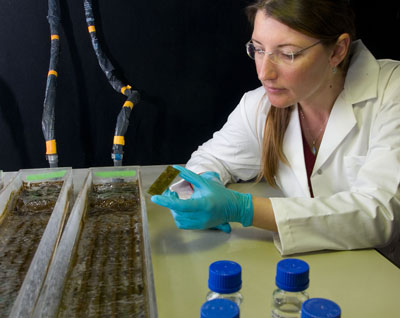| Posted: June 23, 2009 |
Micro- and nanopollutants in water resources: prevention - assessment - removal |
|
(Nanowerk News) At this year’s Eawag Info Day – held on Tuesday, 23 June – the latest findings of research on anthropogenic micropollutants are being presented to more than 350 scientists, water professionals, administration officials and policymakers.
|
|
Increasing numbers of substances – and nanoparticles
|
|
Worldwide, around 11,000 new substances are registered every day. Chemicals are an indispensable part of our daily lives: industrial chemicals, pesticides and biocides, medicines, cleaning agents, flame retardants for furniture and plastics – the list could be extended indefinitely. Ultimately, almost all these substances find their way into natural waters, albeit in some cases in very low concentrations. This is true not only for soluble substances but also for nanoparticles, which – in a rapidly expanding market – are already found in over 800 products. Eawag has demonstrated, for example, that titanium dioxide nanoparticles, used as a whitening pigment in facade paints, are released into the environment in rainwater runoff. Although these pigments are of little concern in terms of ecotoxicology, a joint Eawag/Empa project showed that silver nanoparticles from facades also enter the aquatic environment. Here, they can continue to exert the antimicrobial effects that are desired in the facade, destroying algae and fungi.
|
 |
| Ecotox tests with algae.
|
|
Not just the dose makes the poison
|
|
While research has previously focused on the effects of individual substances under controlled laboratory conditions, it is now becoming clear that the situation in natural waters is considerably more complex: mixtures of substances can produce additive effects, and new stressors – such as increased water temperatures or higher levels of ultraviolet radiation associated with climate change – can create additional pressures for organisms exposed to pollutants. In particular, the classical doctrine that effects are determined by the dose alone has now been called into question. For example, exposure to pesticides typically fluctuates sharply, and Eawag researchers have shown that the interval between two peak concentrations is a crucial factor determining whether organisms are permanently damaged or are able to recover. If this period is too short – e.g. less than 34 days in the case of the freshwater amphipod Gammarus pulex exposed to the pesticide carbaryl – a second wave of contamination will be significantly more toxic, as the organisms have been damaged by the previous exposure. Accordingly, Eawag has developed a model which takes these findings into account and should thus improve risk assessment for chemicals. In addition, Eawag researchers have shown that it is essential for transformation products to be taken into consideration in chemicals assessment and water quality monitoring: in a study involving 37 pesticides, 30% of the transformation products were found to be as toxic as or even more toxic than the parent compound. The transformation products are also frequently more persistent and mobile, so that they can even be detected in groundwater.
|
|
|
|
Fruitful cooperation with manufacturers
|
|
Pesticides are released not only from agricultural sources but also from urban areas, where they are used, for example, in gardens and on sports grounds or as biocides for material protection purposes. In wet weather, these substances are washed away and, if the runoff cannot be stored in retention facilities, pollutants enter receiving waters without first passing through a wastewater treatment plant. This explains the importance of precautionary measures such as increasing the capacity of overflow tanks or improving materials. In the case of bitumen sheets (roofing felt), cooperation between Eawag and industry has resulted in manufacturers changing their formulations and the recommendations for use of their products. Thanks to the change in formulation, the leaching of the herbicide mecoprop (used to prevent root penetration in sealing membranes) has been reduced more than tenfold in new bitumen sheets. Over the long term, in combination with the recommendation that root-resistant products should only be used in essential cases, this should allow a reduction of more than 95% in environmental releases of mecoprop from bitumen sheets.
|
|
Upgrading wastewater treatment plants
|
|
The example of bitumen sheets shows that releases of pollutants can be avoided or reduced by tackling the problem at the production stage. As things stand, however, wastewater entering treatment plants from urban areas contains a cocktail of contaminants. Because our wastewater treatment plants were designed mainly to remove nutrients rather than chemicals, some of these substances subsequently enter receiving waters. As part of the “MicroPoll” strategy initiated by the Federal Office for the Environment (FOEN), Eawag has therefore been investigating how wastewater could be more effectively purified. In a pilot experiment at the Regensdorf plant (Canton Zurich), it was shown that the ozonation of wastewater largely eliminates the toxic effects of micropollutants. The additional treatment step would only increase wastewater charges by about 10%. It could therefore make sense to upgrade wastewater treatment plants, especially where treated effluents are discharged into small receiving waters.
|

